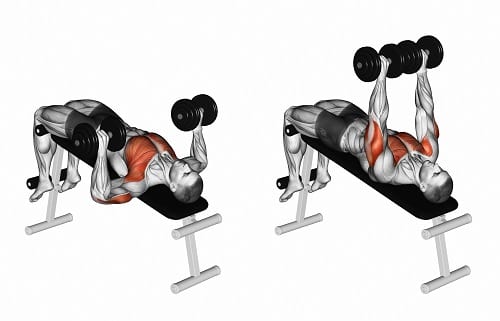The chest press weight and strength training exercise takes many forms and utilizes a variety of equipment, including dumbbells, barbells, bar, and plates, a Smith machine and even resistance bands. It is a versatile exercise that develops mainly the pectoral muscles of the chest.
A qualified trainer is recommended to guide you through appropriate execution, particularly for more serious bench pressing with heavy weights.
Starting Position
Positioning the Body
- Lie on a bench or floor with a dumbbell in each hand. If you use a bench, you may have the feet up on the bench or on the floor, whichever is comfortable for bench height and your body and leg length.
- Position the dumbbells at the shoulders with upper arms at about 45 degrees to the body with elbows forward of the shoulder line to avoid stress on the shoulder joint. The palms should face forward.
- Brace the abdominal muscles, tilt the chin slightly toward the chest and ensure you are in a stable and comfortable position. You’re ready to lift.
Body Movement
- Push the weights upward, taking care not to lock out the elbows in an explosive movement. The weights should follow a shallow arc and almost meet over the top of the chest.
It’s okay to straighten the arms as long as you don’t do it with sudden or explosive force. This can injure your elbows.
Try to move the weights in a controlled, smooth and not-too-fast lift. The head or shoulder blades should not rise off the bench.
- Lower the weights, muscles contracted, controlling the return to the starting position.
To start with, you could try 3 sets of 10 exercise repetitions of an appropriate weight. To familiarize yourself with the proper form and motion of the exercise, start with light dumbbells and pay attention to the motion. If you feel any pain, you should not perform the exercise.
Check Points
- Maintain the natural arch in the lower back; don’t force the back into the surface. This is called the lordotic curve and is a natural stability mechanism.
- Don’t allow the forearms to spread wide so that the weights are outside the line of the elbows. Move in an arc toward the center of the chest but don’t crash the weights together at the top of the move.
- Don’t contort the upper body and shoulders to thrust the weights upward. If you find yourself doing this, the weights are too heavy.
- If fatigue occurs during the final repetitions of any set, reduce the repetition numbers or go for lighter weights. Don’t risk injury to yourself or others.
- It’s okay to place the weights down between sets if you wish. You don’t have to hold them at the shoulders.
- It is always recommended to have someone assist you during a chest press exercise, especially if you’re advanced and using heavier weights. This person is often called a “spotter” and many people are willing to “spot you” if asked.
SOURCE – CLICK HERE


